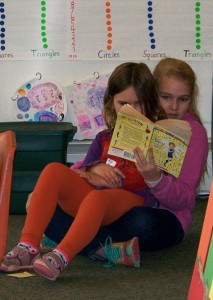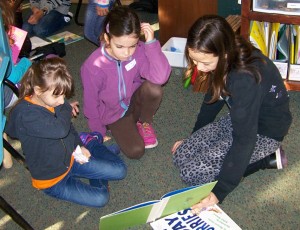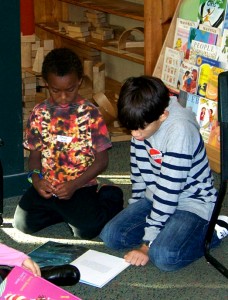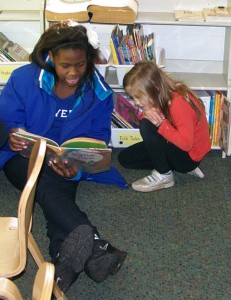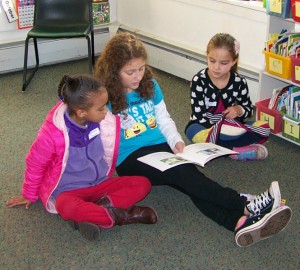“Ours is not to reason why — just invert and multiply.”
Those of you who recall your school math instruction for dividing by a fraction probably were taught the method described above and probably were given no rationale for it. Just learn it and apply it. What if you forget which fraction to “flip”? What if you forget something else about the process? Can you come up with another strategy and get to the right answer? Probably not. At least, that was my school experience. But at Miquon, our instructional goals include conceptual understanding as well as process mastery. So here is a close look at what a couple of our small groups have been doing recently with division by fractions. It’s an example of our typical approach to computation processes.
We started with a review of the meanings of division and multiplication in order to consolidate prior learning and sort out any misconceptions. For example, many students create a false rule in the younger grades when they have been doing multiplication and division only with whole numbers: Multiplication makes things bigger and division makes things smaller. As we work with fractions, they soon realize that multiplying a number by a number that is less than 1 gives a product that is less than the number being multiplied, and a whole number divided by a number that is less than one will yield a quotient that is greater than the number being divided. For example, 6 x 2/3 = 4, and 6 ÷ 2/3 = 9.
We then moved on to dividing whole numbers by unit fractions. How many thirds are in 15? Always there are students who will quickly say “5.” When that happens, we ask, “Then how many threes are in 15?” Oh. A sudden insight and an embarrassed chuckle. After a bit of thought, students arrive at 45 thirds in 15, which is the correct answer. We go through many more examples: fourths in 12 (48), halves in 20 (40), fifths in 10 (50), eighths in 6 (48), and so on. Soon students start offering a rule: You just multiply by the denominator — for thirds it’s times-three, for fifths it’s times-five — because that’s how many parts it takes to make one whole. This is thinking that helps to make sense out of that invert-and-multiply algorithm. Math should always make sense. There are no “tricks.” But we don’t start with invert-and-multiply.
 Method #1: Manipulatives and visual representations are important to this and most other math instruction. We use fraction sticks and Cuisenaire rods, make diagrams on paper, and use number lines. Let’s set up a sample problem to solve with this and the methods that follow: 3/4 divided by 1/3. We discuss whether the quotient should be greater or less than one.We are dividing a greater amount by a lesser amount, so we should get a quotient that is greater than one. This is an important but simple way of checking our answer for reasonableness.
Method #1: Manipulatives and visual representations are important to this and most other math instruction. We use fraction sticks and Cuisenaire rods, make diagrams on paper, and use number lines. Let’s set up a sample problem to solve with this and the methods that follow: 3/4 divided by 1/3. We discuss whether the quotient should be greater or less than one.We are dividing a greater amount by a lesser amount, so we should get a quotient that is greater than one. This is an important but simple way of checking our answer for reasonableness.
For the first problem, we’ll use some of the fraction sticks shown at left. (We could just as easily do jumps on a number line or draw a rectangle on graph paper.) We need three of the 1/4 pieces and some of the 1/3 pieces. We line up the fourths end-to-end. Next to them, we line up the thirds the same way. How many thirds does it take to equal the length of the three-fourths train? Two of the third-size pieces fit along with part of another. (It’s a happy coincidence that the image shown here actually illustrates that.) So the answer is greater than 2. But what about that partial third? How much of it fits the three-fourths train? A little investigation with other pieces reveals the part — it’s a fourth of the partial-third piece. So 3/4 ÷ 2/3 =2 and 1/4.
Invariably, at least one student says something like But I thought we were dividing by thirds. Isn’t it 2 and one third? This is a pivotal question. Fractions refer to parts of a whole. What is our whole? It’s what we are dividing by. We are dividing by one third. So the quotient is 2 complete thirds plus one-fourth of another third. It’s hard to over-emphasize how important this understanding is. It’s what makes computation with fractions so difficult. The whole is always there but often just implied. Technically, the one-fourth in that quotient is a fourth of a third of a whole. There are really two different “wholes” — the one that defines the third and the one that defines the fourth. If we don’t use manipulatives and visual models, if we just teach a series of computational steps, this may never be questioned and understood. It may take many exposures to this kind of task many times through fifth and sixth grade before it doesn’t wobble into confusion. So we do it many times and in many different contexts.
Method #2: Students learned how to change two or more fractions to equivalent ones that had a common denominator when they were learning to add, subtract, and compare them. It may not be secure learning yet, but it’s a familiar process. So let’s do that with our sample problem. We can transform 3/4 divided by 1/3 into 9/12 divided by 4/12. At this point, the fact that we are working with twelfths is unimportant. We have a set of 9 things, and we want to break it into groups of 4 things. We will end up with 2 complete groups of 4 and 1/4 of another group of 4.
Method #3: When we multiply fractions, we multiply across. That is, the numerators are multiplied to tell us how many pieces we have. The denominators are multiplied to tell us what has changed about the size of the pieces. So why can’t we divide across? Isn’t division the opposite of multiplication? It is, and we can. It’s just that some problems are easier to do this way than others. Let’s set aside our example problem for a moment and look at one that is easier to understand. How about 4/9 divided by 2/3. Two goes into four 2 times, so the numerator is 2. Three goes into nine three times, so the denominator is 3. The quotient is 2/3. It works. (We can check it with multiplication: 2/3 times 2/3 is 4/9.) Now let’s look at our sample problem: 3/4 divided by 1/3. One goes into 3 three times, so our numerator is 3. Three goes into 4 one and one-third times, so our denominator is one and one third. That’s mathematically valid, but it’s also needlessly complicated. To simplify it, we’ll multiply the numerator and denominator by 3 to get an equivalent fraction and wipe out that inconvenient fraction (thirds) in the denominator. Here a student says, “Why are we multiplying by three?” So we go back to the number of parts it takes to make a whole — three thirds, five fifths, eight eighths — and the student constructs a new rule for herself. We can simplify a stacked fraction by multiplication, just as we simplify other fractions by dividing by a common factor. Back to the problem with the awkward-looking quotient. Three times the numerator is 9. Three times the denominator is 4. And nine fourths resolves to 2 and 1/4. Same answer yet again.
Method #4: Yes, it’s time for invert-and-multiply. We have explored division by a fraction through three different methods that all yield the same answer, and we have had a number-sense discussion that has led students to come up with a rule for dividing whole numbers by unit fractions. So it’s time to take on the method most parents know (but most can’t justify or explain). How many thirds are there in 6? Eighteen. Yes — so how many groups of two-thirds are there in 6? A few students suggest 36. Others say 9. Which is it? Out come the fraction sticks again. Oh. It’s nine. Why is it less? Because two thirds are a bigger piece than one third. So let’s keep working on that rule. Eventually, we have one that works. To divide by one third is the same as multiplying by three. To divide by two thirds means multiplying by three and then cutting it in half. So one third goes into 6 eighteen times, and two thirds goes into 6 nine times.
Can we come up with an algorithm? Let’s learn about reciprocals. The word reciprocal describes a relationship, and that’s not just in math class. (We take a moment to talk about reciprocating when someone gives you a compliment or a birthday present, and we also find out how a reciprocating saw works. Then back to math.) Two numbers are reciprocals if, when you multiply them by each other, the product is 1. So 3 times 1/3 = 1. Five fourths times four fifths equals one. Try out a lot of fractions like those on your calculator. Got a rule for fractions? Yes — just turn it upside down. Can we write any number as a fraction? Yes. Seven is just 7 over 1. Three and a half is 7 over 2. So the reciprocal of three and a half is 2 over 7. One way to divide by a fraction is to multiply by its reciprocal. That is, we can use the opposite operation (multiplication instead of division) and the opposite fraction (3/2 instead of 2/3). What we are dividing cannot and does not change. But the operation and the divisor can. So we can solve our sample problem this way, too. We will rewrite 3/4 divided by 1/3 into 3/4 times 3/1. Three times three is 9. That’s the numerator. Four times one is 4. That’s the denominator. And we already know that 9/4 = 2 and 1/4 because we’ve solved this problem three other ways.
A side note: Every fraction is a division statement. Any division problem can be expressed as a fraction. Sometimes we can solve the problem just by writing it in that format. The numerator is what is being divided. The fraction bar is the division symbol. The denominator is the divisor. What is 11 divided by 17? Write 11 as the numerator, 17 as the denominator . . . and you have the answer: 11/17. How many times does 2 go into 3? Write it with 3 as the numerator and 2 as the denominator. You have 3/2, which simplifies to 1 and 1/2. One of the standard symbols for division is this one: ÷. It’s actually a picture of a fraction with a dot for the numerator and the denominator. Another symbol for division is this: /. That’s a fraction bar, the line that separates the numerator from the denominator. Every fraction is a division statement.
_________________
How long does it take to teach all this? A lot of time, and it’s not accomplished all at once. The stronger a student’s background is, the less time it takes, but we can get everyone there.
We have several important learning goals that we want students to embrace:
1) Answers should be reasonable and should be checked for reasonableness.
2) Answers can and should be justified in conversation with peers.
3) Problems should be solvable in both visual and computational ways.
4) Mathematics work should be based on number sense and conceptual understanding, not on memory of rote processes.
5) Mastery of number facts makes many things easier — estimation and computation, especially.
________________
So we hope you have gained some understanding through this detailed example of what we do in math classes all year long, for every topic. And we want to remind you that it’s quite all right for students’ homework to come back with mistakes and questions as well as right answers. All of this tells your child and the teachers what does and does not need to be done in math class the next day. Homework is a tool for planning, not for judgment.


